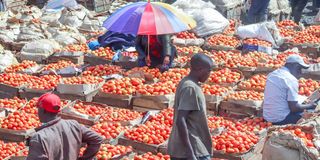Agronomist notebook: Tomato trends in a changing market

Tomato traders at Kongowea market in Mombasa this past week. The smallest crate of the produce is being sold at Sh1,500 and the biggest Sh3,500 due to increased supply in the market.
What you need to know:
- Importation of tomatoes from neighbouring countries such as Ethiopia has also seen an oversupply of the product amid a depressed market.
- A majority of consumers consider buying tomatoes that are not affected by Tuta absoluta or other pests and diseases as they have a longer shelf-life. Thus, ensure your tomatoes are disease-free.
- If under contract farming, go for a reputable company, organisation or buyer that can collect as per the agreement.
Tomatoes are among the most widely consumed vegetables, hence their high demand. At the beginning of the year, the demand for tomatoes was too high, resulting in extremely high prices.
Depending on the size, one fruit was selling at between Sh10 and Sh20. This was attributed to the high rainfall received towards the end of last year, which led to a conducive environment for tomato diseases to thrive, cutting production.
Because of the high demand then, many farmers opted to plant tomatoes in large scale in the following seasons.
This, coupled with the fact that many have embraced farming due to Covid-19 challenges that include job losses, had led to a rise in production.
Importation of tomatoes from neighbouring countries such as Ethiopia has also seen an oversupply of the product amid a depressed market.
Tomato prices
Tomato prices have significantly dropped, with a kilo going for as low as Sh30. In Kajiado town, for instance, car-boot sellers are supplying the produce to retailers as well as consumers. It is the same case in most parts of the country.
A majority of consumers consider buying tomatoes that are not affected by Tuta absoluta or other pests and diseases as they have a longer shelf-life. Thus, ensure your tomatoes are disease-free.
Also, before selling, grade the tomatoes depending on the size. For instance, from big to medium to small.
The ripening stage of the tomatoes is also a factor as some prefer ripe tomatoes and others those that are breaking the colour since they have a longer shelf-life.
To be able to sell effectively, one must arrive in the market as early as 6am, our research showed.
Contract farming
Having this in mind, farmer Moses carried out all the management practices to ensure we produce the best quality tomatoes.
We had also identified a buyer with whom we signed a contract. This is referred to as contract farming where one identifies the buyer and agrees on the price the product will be bought.
This ensures the farmer has a ready market. In Moses’s case, the agreed price is Sh40 per kilo for grade one.
On average, one can break even by selling a kilo at Sh20.
If under contract farming, go for a reputable company, organisation or buyer that can collect as per the agreement.
You should also agree on the mode of delivery and payments to avoid delays after delivery of the produce.
Market fluctuations
In most cases, contract farming requires one to be able to supply specific quantities of product throughout the year.
To achieve this, one should have continuous production or opt for the greenhouse, where one can harvest for a longer duration.
Depending on the size of the land, two or more farmers may jointly supply one buyer.
This reduces post-harvest losses incurred as a result of inadequate market or the farmer incurring losses as a result of sudden market fluctuations. Some of Moses’ tomatoes are ready for harvesting.
In our next article, we shall look at the maturity indices for tomatoes.





